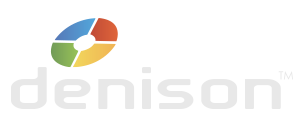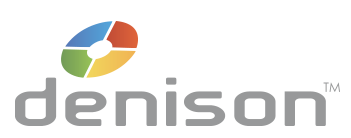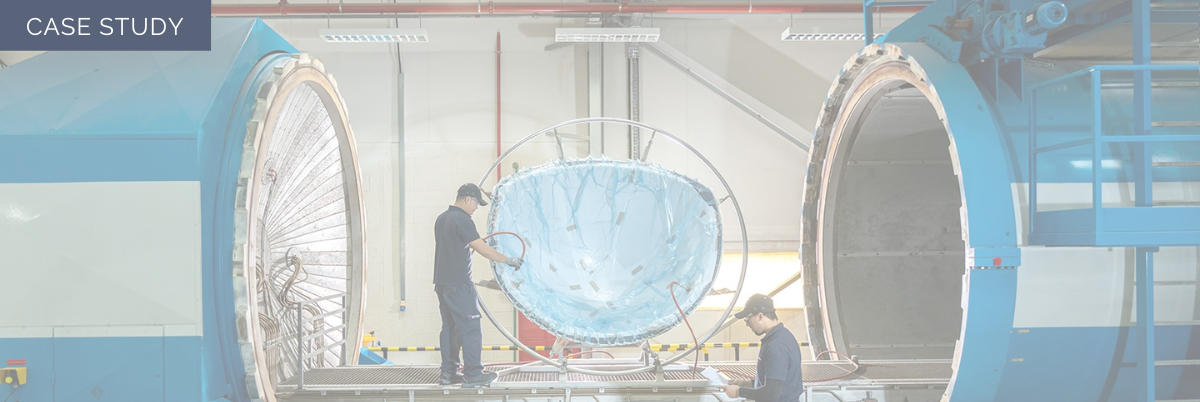
Safran Aerosystems
Aligning Leadership Around Culture to Drive Purpose – Shaping a Cleaner & Safer Sky
Karen Jones, Managing Director of Consulting and Partnerships for Denison, Consulting Europe
Sebastian Weber, CEO of Safran AEROSYSTEMS
Back in 2021 Safran AeroSystems were, like the rest of us, starting to recover from the pandemic. They initiated their transformational journey, aiming at greater operational performance and setting the right vision and culture for the company. They came to Denison Consulting in Europe to conduct a baseline cultural assessment with their top 400 leaders to highlight the areas for improvement, and maybe, some celebration as they embarked on this journey.
Safran AeroSystems is a Safran unit with over 5,000 employees across the world, in 22 sites located in 7 different countries. The workforce at Safran AeroSystems is diverse, with little over half of the employee base in France, which is important. It is a French Corporation, with around 30% of the teams in the Americas, and the rest, elsewhere in the world in the Middle East, in Singapore, and in the UK.
Sebastien remembered how Karen said that they should not talk about culture outside of context, and it was especially significant for Safran AeroSystems. There was the pandemic that everyone lived through, and they were acquired by Safran Group in February 2018. A change of scope followed this acquisition, with a significant reduction in business. They had two operational divisions with very different economic profiles. One being healthy, but the other struggling a bit more. About half of the revenue comes from aftermarket care, so serving the customers is very important. The aftermarket care, prior to the pandemic, was organised as a separate business unit.
Sebastien joined the company early in 2021 mid-pandemic. Traveling between his base in the USA and the head office in Paris, his priority was to co-create the transformational plan with his team. The focus of this plan was:
- To integrate aftermarket services into Safran AeroSystems and turn it into a seamless organisation.
- To organise and align the organisation with ‘The Safran way of working’.
- To merge the multiple French-based legal entities into a single one.
- To address the significant retention problem.
- To align his leadership team, some of whom had been formerly with Zodiac before the acquisition, and some were new. The team was struggling to work at its maximum potential, to make agreements, and to work as one. There was a lack of understanding of where they were trying to go. People were lost after the changes that occurred since the acquisition by Safran.
Sebastien firmly believed in leadership from the top, and that when the top leadership team doesn’t function as well as they might, neither will those managed by them. Sebastien wanted to start in a manageable and economical way and decided to start their cultural journey with a smaller group of his 400 leaders. His Human Resources Director (Didier Rivron) had experienced the Denison cultural diagnostic before, but it was new for Sebastien.
Sebastien was honest enough to admit that the first time he saw the baseline results, he was not very happy, “It’s hard not to take it personally.” On second view the next day, however, he concluded, “These are our people speaking, and this is the message they want to convey, and it’s exactly why we did the diagnostic in the first place…I could sense that something was not right.”
2022 Safran Aerosystems Overall
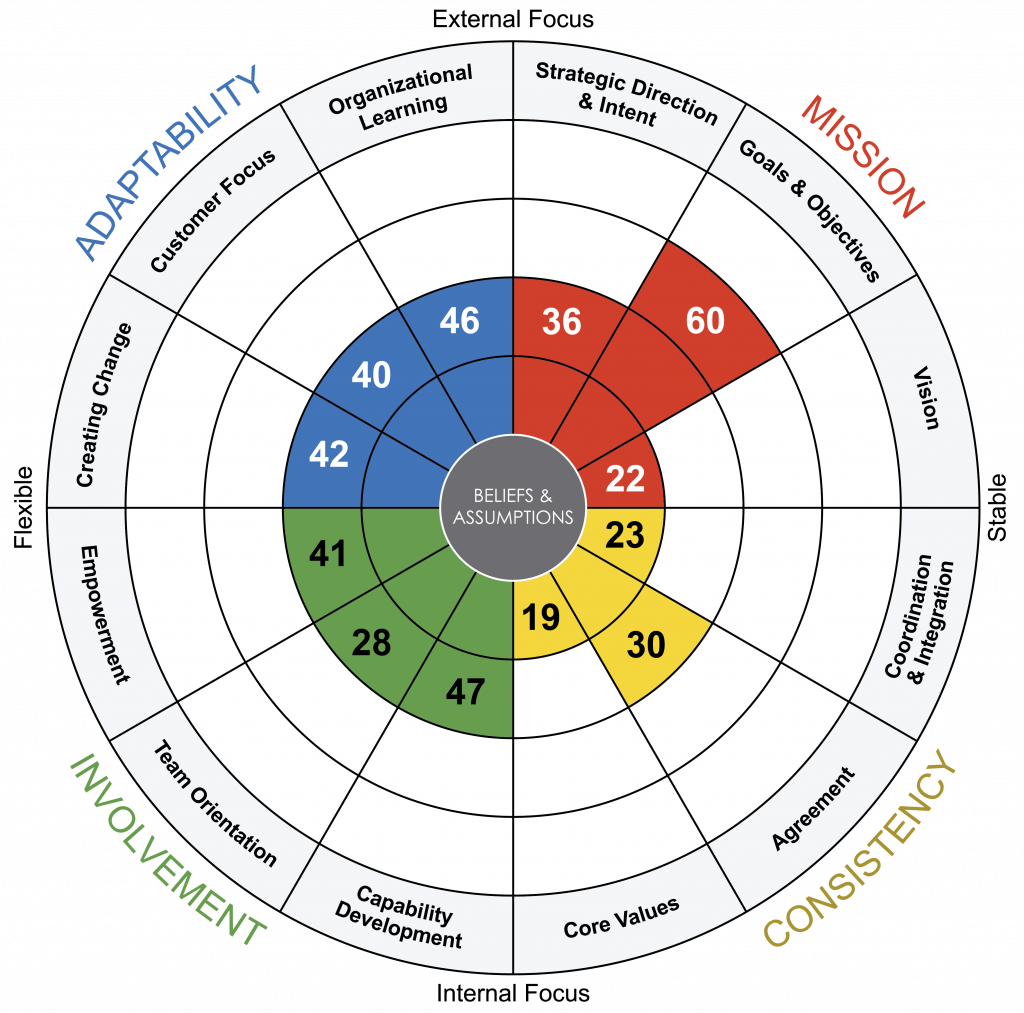
N = 298/380 (78%)
The participation at this level was lower than Sebastien had hoped for, although it matched the average response when companies invited their whole workforce. Sebastien expected nearer to 100% of his top leaders to respond to his request to complete this diagnosis. It left him wondering if the response choice aligned in any way with the results found.
They wanted to segment this data further to explore the different management levels and the impact of the cascade for maintaining clarity and alignment.
2022 Level of Management – N0
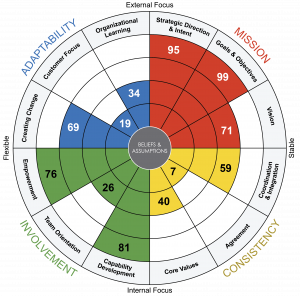
N = 10/11 (91%)
2022 Level of Management – N1
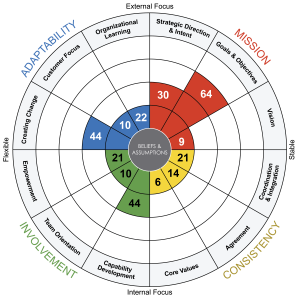
N = 46/52 (88%)
2022 Level of Management – N2

N = 109/132 (83%)
2022 Level of Management – N3
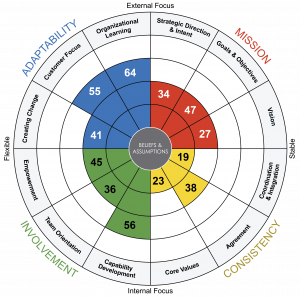
N = 133/185 (72%)
Sebastien was struck by the discrepancies between his direct reports (N0) and their direct reports (N1). Consistency appeared to be one of the most common challenges. Their strength appeared to be in the short-term goal setting. The data seemed to reflect the positive heritage around innovation. One of the legacy core values was entrepreneurship, which many felt was ingrained within the organisation as many of the employees were formally with Zodiac. Sebastien resonated with the data, which suggested that finding agreement was a challenge, and he also acknowledged that they were missing clarity on their core values. What really struck Sebastien was the fact that even his own team (N0) acknowledged this and that they overestimated how they were perceived by their direct reports in terms of practicing what they preached.
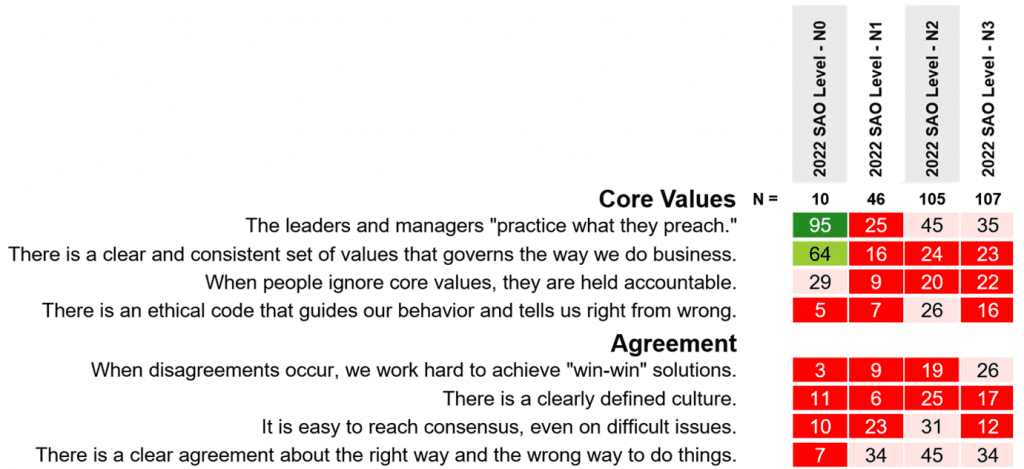
They had defined core values in the past but later transitioned to a leadership model. This data implied that the core values were no longer discussed or embedded. This gave Sebastien and his team a strong invitation to rethink their approach to core values.
The data was segmented by country:
2022 Country – France

N = 173/216 (80%)
2022 Country – Mexico
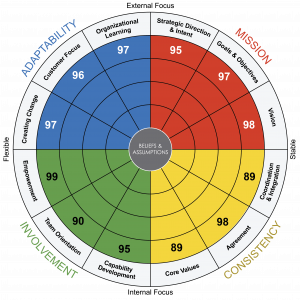
N = 58/64 (91%)
2022 Country – Singapore
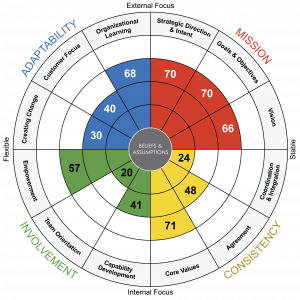
N = 7/15 (47%)
2022 Country – UAE

N = 10/12 (83%)
2022 Country – UK
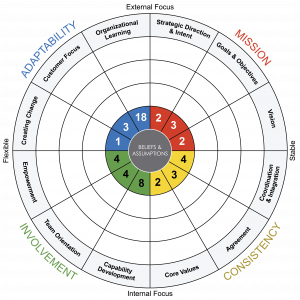
N = 7/10 (70%)
2022 Country – USA
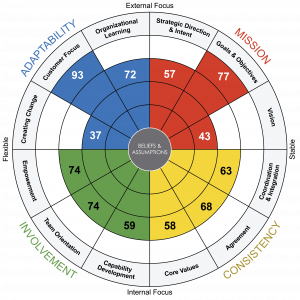
N =43/63 (68%)
There were clear discrepancies between the beliefs and assumptions of the top leaders within each region. Our research does tell us that South America and Asia tend to score more positively. Sebastien was also very conscious that this known difference did not undermine his knowledge that Mexico had a great team that worked well together. The data highlighted that France and the UK needed to be heard and the challenges emerging from their current context understood.
Sebastien and his ExCom (11 people) spent a day together in Paris, where Karen took them through their baseline results. The invitation was to ‘be curious’ rather than judgmental. They began to explore their own curiosities within the feedback their colleagues were sharing with them. Sebastien heard this data as an “invitation to change.” The ExCom began to prioritise the corporate areas for further focus, one of which was for the ExCom to spend more time together exploring what they believed and assumed to be true of each other.
In December 2022, the ExCom organised their own leadership off-site, again working with Karen to explore how they could become more cohesive as a team. They knew there was an expectation for them to role model what would be expected of others as they began to create their high-performance culture and that they were inviting others to build with them. Sebastien stated that this time together, “started the honest conversations” that had been absent. Sebastien shared, “It was the first time my team had an opportunity to address some of those topics. It was also an opportunity for me to directly address it with the team in a non-judgmental way.” Sebastien modeled ‘openness’ to build trust in a very powerful and authentic way, and completely met Karen’s invitation to be brave and honest and speak from the heart with his team. For Sebastien, he felt better because there was a moment where he believed his team ‘pivoted’ and they were able to truly work on some of the priority areas, with a clear and agreed action plan.
Sebastien wanted to share this data with his top 100 leaders, these leaders who would then reach out to 5,000 people across their teams. In January 2023, he invited them all to an off-site management meeting which Denison co-created and facilitated around workshops. This event gave Sebastien the opportunity to share the vision with everyone at the same time and discuss the achievements that had been made and confirm the challenges ahead. This event gave them all the opportunity to see and discuss the data and reflect on their current habits around the four traits of high performance (Mission, Involvement, Adaptability, and Consistency).
There was work to do for everyone, and Sebastien felt it was helpful to know their baseline results to be able to measure the progress and the impact of any action they were to take. For Sebastien, France had a larger workforce and therefore greater overall impact on the business, so this was an area of priority for him. France was also the region that had been most affected by the transformation plan. The USA has had very stable leadership over the years, and in France, there have been a lot of new leaders and many changes.
The active workshops invited people into discussion groups around each of the traits of high performance. They were asked to consider what are the:
- Good old habits that we need to preserve and strengthen.
- Bad old habits that we need to unlearn and let go of.
- Bad new habits that we need to rethink and try again.
- Good new habits that we need to invent and perfect.
Four clear priority areas emerged:
- How do we establish and embed core values for greater accountability on behaviour and align to our leadership model?
- How could we benefit from healthy conflict, welcoming diversity of thought to make the best decisions for SAO?
- How can we share our vision & strategy across the whole organisation, so that everyone lives and personifies it, to drive commitment and a sense of belonging to one SAO?
- How do we best cascade (vertically & horizontally) our objectives in an empowering way, to prevent reports from feeling caught in the middle between competing priorities?
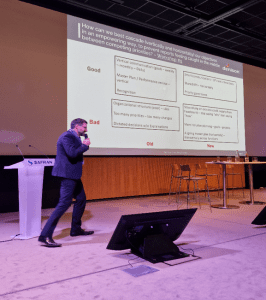
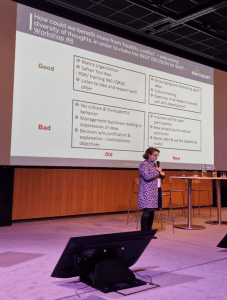
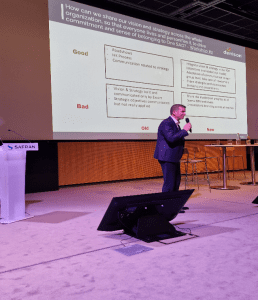
This event was a success for Sebastien as he felt “we had been open and honest with people, and they were really cooperative sessions.” Sebastien has since completed his CEO roadshow around the 17 sites across the world, addressing 95% of the sites in 2 months. This tour cascaded the vision to all employees and shared performance results and priorities for action and high-level goals. It invited everyone to understand their contribution to the journey.
Sebastien and his team did not stop there. They held a webinar for the 380 managers that were surveyed. This was part of an ongoing process of having regular engagement with the leaders, updating them on progress, and reemphasizing their vision. Following the webinar, smaller working groups were created to address the four priority areas for action. The ExCom completed its first meeting in June 2023 to set the direction for core values.
What’s Next for Safran Aerosystems
Based on the inputs from the workshops and the Core Values prepared by the ExCom in June 2023, multiple focus groups were organised to address the four priority areas. These focus groups are meant to be diverse culturally and organisationally with the objective of providing recommendations on the proposals made for the four priority areas. Sebastien will target a larger communication and a roll-out with the top 400 leaders in the fall of 2023. This will be followed by another management meeting at the beginning of 2024 in order to anchor the “new way” of working and gain ownership of the leaders.
How would Sebastien summarise his experience of diagnosing the beliefs and assumptions of his top 400 leaders, using the Denison organisational culture diagnosis?
- Denison provided a solid reference point. Even if you don’t like your results, they tell you where the journey starts.
- You need to be ready to receive and accept difficult feedback,
- You need to be clear on ‘why’ you are doing this and make sure everyone else is clear. There was a lot of credibility gained by sharing the culture results. This drove a commitment, from everyone, for change.
- This must be driven by the leadership team and modeled in their behaviour.

